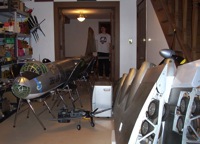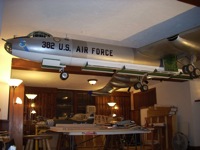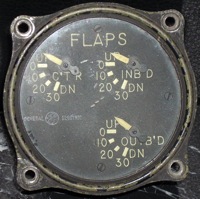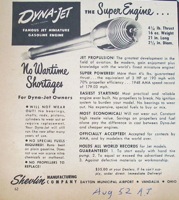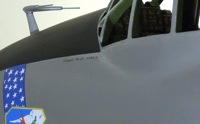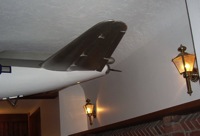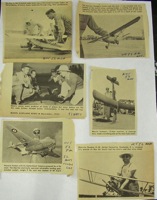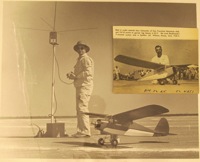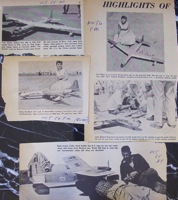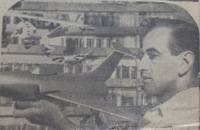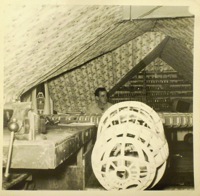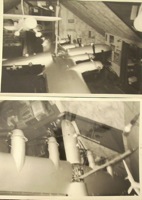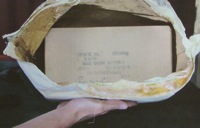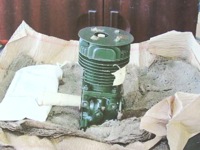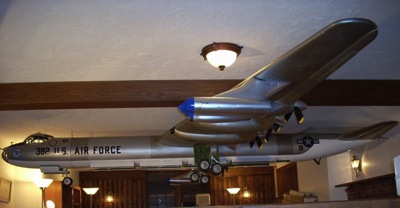Special Exhibit:
World’s Largest B-36?
Restoration/Electric Conversion Project

(Click on any of the images on this page to see a larger version)
Why This Model?
▪ Is it the largest model airplane in the world?
No. While its one of the very largest, bigger RC models exist, at least in Europe. In 1987, the Byron Company built a 400 pound fiberglass B-29 and flew it at elaborate shows in the U.S. to promote Byron products.
- Is it the largest B-36?
At 1/9 scale, with its 26 foot wingspan, it’s the largest we know of. There may be others built by corporate or government facilities, not hobbiests, or which are not RC or not flyable, but they would be in a different category anyway.
Its size is extraordinary, but that’s not why its here.
▪ Is it the scale features?
- 6 Working flaps
No, its not these scale features. It’s a remarkable scale model. However, some features seem off-scale a bit, and competition scale models today have far more detailing right down to the rivets.
The Answer
What elevates this model airplane above the others is when it was built.
1952.
That’s right, 1952! President Truman was in the White House, all airliners had propellers and a new car cost $1,700. This is an actual contemporary of the full-scale B-36s-- built at the same time as real ones.
In 1952, most model airplanes were smaller than this model’s tail, and RC radios had a hard time managing even a small, high wing craft with lots of dihedral for inherent stability. Here is the leading RC radio in 1952 and some typical airplanes:
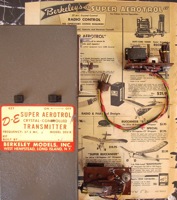 | 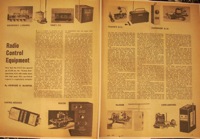 |
Here are examples of the world’s best model airplanes in the 1952-53 era , as seen at the Nationals:
The most advanced RC model back then was this Nationals-winning cub built by Alex Schneider. Schneider and his San Francisco Mustangs pioneered reeds, a milestone advance in radio control. See Video Gallery. Their Rockwood Radios achieved control of rudder, elevator and engine which surpassed anything else back then. Still, their radio control was maintenance intensive, power and performance limited and highly unreliable by today’s standards.
So how was this B-36 possible? A ten engine, 350 pound scale model of the largest airplane in the world, built long before model engines and radios had developed enough to propel and control it?
Was it alien technology or something?
Salute To James Pappas
The alien was named James Pappas. He worked out of the attic of his mother’s humble home in the inner-city of Indianapolis, Indiana. There, in his 20s, this modeling genius overcame crushing poverty and single-handedly created the most impressive model airplanes in the world. Planes way ahead of their time.
That’s why the B-36 is here today. Had reliable radio control existed back then it would have been flown, and eventually…. Well, you know. We still have some “eyewitness accounts” of the B-36 flying which we need to evaluate/debunk. But, so far, we doubt it was ever flown. At least no more than a few feet off the ground for a hundred yards or so, to prove the concept like Howard Hughes did with the Spruce Goose.
Skepticism is healthy. Over many years and many owners it is understandable that there were two persistent objections to this striking model:
- “It must be a fake built in modern times”
- “It must have been built by Convair Corporation or by the Air Force with unlimited resources”
We now have documentary and photographic proof to the contrary.
This newspaper article records the already stellar achievements of James Pappas and the commencement of his Magnum Opus—the B-36D.
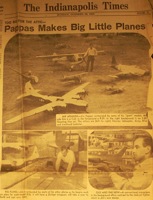 |  | 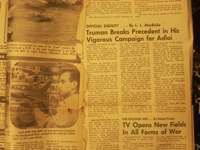 |
Here’s Pappas working on the B-36 in late 1952. For a span of years he devoted himself to these models, working only part-time, occasional jobs to raise funds for the airplanes and spending most of his days on their construction. His brother, who has been so helpful in tracing this history, recalls that all his planes were built from mere photographs. He had to then draw up his own plans, then fabricate his own parts, then assemble everything.
Every one of his great models was built in this tiny attic of his mother’s house where he lived to save money so he could spend it all on the models.
Although the wings are removable and the fuselages break down like today’s giant scale models, even the individual components were too large to maneuver downstairs. Instead, they would be taken out the double window of the attic onto the roof of the house.
Here are some additional photos of the “big-money corporate and government facilities” which produced the world’s best model airplanes. Notice the train tracks which ran almost through the house, and the surrounding factories in this gritty, inner-city neighborhood.
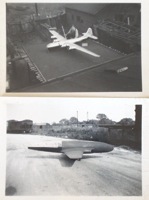 | 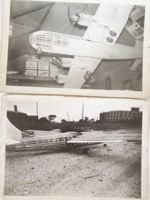 |
Please contact us if you have additional information or know the whereabouts of the other Pappas Giants.
Belle Of The Ball
James Nick Pappas won many awards and contests with his models. Not surprising. They eclipsed everything else at shows and were really in a category all their own.
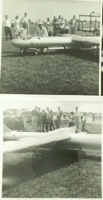 | 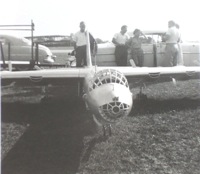 | 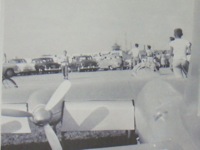 |
In 1955, the B-36 was the centerpiece of the Air Force ROTC Ball. Note the ROTC-Queen’s hand is on the plane’s antenna.
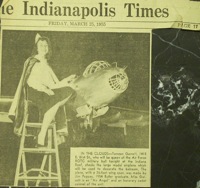 | 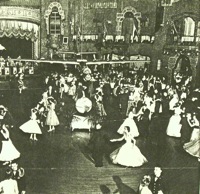 |
This was a car antenna which survived, with wiring, until the previous owner revamped the forward fuselage section in 2010. Vertical antennas, especially long ones, offered advantages for radio control back then. One expert speculates this was part of a system which did more than control the engines and steerable nose wheel for taxi demonstrations. Even if the engines were inadequate, he believes, the B-36 may have been flown in “ground effect”, over full-scale, concrete runways, using pendulum stabilization for the ailerons. This would require radio control of only the rudder and elevator plus a kill switch for the throttle (linked to the drogue chute perhaps?).
Aside from this possibility of a Spruce Goose-type hop, any RC in it back then was probably for ground demonstrations only. The original engines, contained within the nacelles, were replaced with these larger gas jobs which MAY have provided sufficient power for flight. One clue Pappas did not build this beauty for display was his purchase of 20 engines--10 mounted plus 10 spares for back up. As recently as 2009, the spares were still with the plane, still in their original boxes.
Here’s an example of the huge ignition coils and built in gas tanks for each of these engines. With electric motors it will be possible to restore the nacelles to their original appearance and enjoy even greater power.
For years, the ship was confined to ground duty, or short hops, as Pappas waited for radio control technology to catch up with him. Over half a century has passed.
No need to wait any longer.
To Fly Or Not To Fly?
That is the question.
This plane was acquired for one reason only—to fly.
The technology exists today to convert this beauty to brushless/lithium power while substantially reducing the total weight. It will be even more feasible in future years.
But we’re having second thoughts. We’re torn. On the one hand, we could honor the memory of James Pappas by proving his masterpiece really could fly. On the other hand, why subject this one-of-a-kind, historic airplane to such a risk? Maiden flight risks are always serious and would be much more so in this case. Consider, for a moment, the hurdles which must be cleared before we would fly this giant. Perhaps one or more of these will prove insurmountable and decide the matter for us.
Hurdles
We welcome opinions on these factors which may preclude a flight attempt, especially if empirically based (e. g. cubic wing loading comparisons or actual experience with aged glue joints while flying 1950s vintage models). Each of these hurdles was cleared before we bought the plane for flying purposes. But the conclusions reached then were necessarily rushed and only preliminary. Further evaluation may alter the final verdict.
1. Legal.
We will need a legal and proper way to fly such a large, heavy plane. It greatly exceeds the AMA’s weight limit, even with a waiver. One example of how this might be done is the Monster Planes meet in Florida, where there is no weight limit.
2. Space.
We would need a much larger clear space and runway than normally enjoyed by modelers, e.g. an abandoned military base or airport with paved runways.
3. Weight.
The wing loading would substantially exceed that of typical Giant Scale Models. Would it be too much for normal, safe control and speeds? As the size of a model increases, much higher wing loadings are possible, in fact normal, without any adverse effect. This is due to scale effect, Reynolds numbers and the like. But exactly how many pounds could this 58 square foot wing handle without pushing it?
4. Fundamentals.
We will need to confirm there are no problems like incorrect incidence or structural design deficiencies. Initial indications are this was built to fly and built well by someone who knew what he was doing. Aside from his modeling prowess and experience, Pappas evidently studied full scale planes and consulted more than one aeronautical engineer for this project.
Pre-acquisition evaluations indicated the ship was built light and right for flight—not merely as a display model. Subsequent examination reinforced this view. Then, weeks after its arrival here, we located one of the prior owners. He told us to look in the bomb bay transport tube.
We found a specification sheet Pappas left there like a note in a bottle tossed into the sea of time.
This sheet first details how the ship is 1/9 scale, and specifies “White Gas” for the jet engines and “70/oil White Gas” for the others. Then the conclusion:
“POWERED BY SIX [piston] ENGINES AND FOUR DYNA JET ENGINES.
CONTROLLED IN FLIGHT BY RADIO.”
5. Power And Control.
Although future systems will be even better and cheaper, electric power seems feasible today, even for the 4 jets. An “extra safe” redundant radio system (e.g. 2 transmitters, 4 receivers, drone actuators) should present no major problems. Overall, we should be able to surpass the power, control and reliability that the Byron Corporation had for its comparable sized B-29 in 1987. To top this off, huge reductions in weight are possible by moving the batteries forward (with capacitors, maybe even to the nose) eliminating much of the need for lead to achieve C.G., and by replacing heavy 1950s steel braces, fittings and control rods with today’s carbon fiber and titanium materials.
Hurdle 5 will be very expensive, complicated and require a lot of practical engineering to pull it all together---but its not a show stopper. Still, when you get into the specific equipment, watts, dollars and weight involved, this becomes formidable. Waiting a few years to see if EP price and performance continues to improve is not a bad idea.
6. Infirmity—Aged Wood.
Does balsa or spruce become brittle or otherwise infirm with age? Initial tests indicate no problems here.
7. Infirmity—Aged Glue.
Has the glue (probably Ambroid) become brittle or unsafe with age due to hardening, crystalization, or the like? The huge reduction in vibration/shaking with electric power will help and the airframe will not be subjected to aerobatic levels of stress anyhow. Initial tests indicate good strength, but the question remains. We need to learn a lot more about this.
For Now
No need to rush.
We’ll just take our time, evaluate comments, and gather information, on the above Hurdles. If it turns out one can’t be cleared we will be relieved of a difficult decision, and pleased to keep this big girl on display.
We’ve grown accustomed to her face, and won’t mind having her around permanently.



